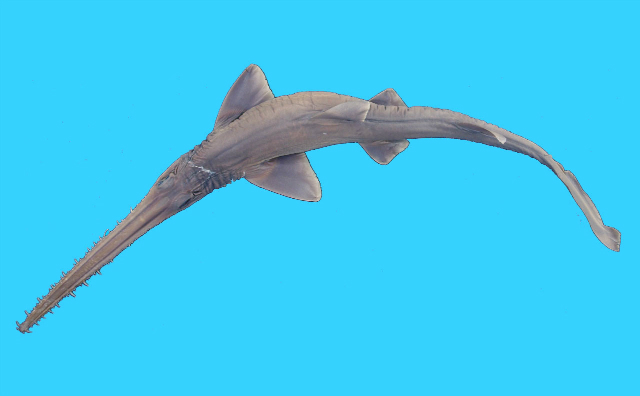ADVERTISEMENT
Filtered By: Scitech
SciTech
New sawshark species discovered in PHL
By MIKAEL ANGELO FRANCISCO
For people who have seen the Jaws movies – or anyone even vaguely aware of what a shark is, for that matter - it’s reasonable to expect that sightings of sharks would be sufficient reason for alarm or even panic.
However, this particular shark sighting might actually be welcome news: a new species of sawshark (Pristiophoridae) was recently discovered in Philippine waters.
However, this particular shark sighting might actually be welcome news: a new species of sawshark (Pristiophoridae) was recently discovered in Philippine waters.
The new species, named Pristiophorus lanae, was identified by scientists from the United States after examining seven specimens captured in Zamboanguita, Apo Island and in Southern Luzon’s Balayan Bay and Ragay Gulf.

Photo credit: David Ebert, via Sci-News.com
Shark tale
Sawsharks have been found in western Atlantic (near Florida, the Bahamas, and Cuba), the southwestern Indian Ocean (off South Africa), and the western Pacific (Australia, Japan, China, Korea and the Philippines). Sawsharks are said to have lived as early as 90 million years ago, alongside the dinosaurs of the late Cretaceous period.
Characterized by their long, sword-like snouts, these bottom-dwelling sharks bear an uncanny resemblance to sawfish. However, a key difference between the two is the location of their gills; the sawfish’s gills are located underneath its head, while sawsharks’ gills are on the sides. Additionally, sawfishes tend to grow much larger than sawsharks; while the largest known sawshark clocks in at a length of 170 centimetres (about 5’ 7’), sawfish can grow to about as long as 7 meters (close to 23’).
Sawsharks possess two spineless dorsal fins, two pelvic fins, a caudal fin (tail fin) with a long upper lobe and no lower lobe. Sawsharks also lack an anal fin. A sawshark's short mouth is full of sharp teeth (usually alternating between small and large sizes).
They also have long mustache-like appendages called barbells, which extend from the middle of their snouts. Working in conjunction with electro-receptors located under their saws, sawsharks are able to use these barbells to detect and catch prey hiding under the sandy bottom of their habitats.
They also have long mustache-like appendages called barbells, which extend from the middle of their snouts. Working in conjunction with electro-receptors located under their saws, sawsharks are able to use these barbells to detect and catch prey hiding under the sandy bottom of their habitats.
Welcome to the family
A five-gilled sawshark with a slender body that grows up to 80-85 cm long, Pristiophorus lanae is the second shark from the Pristiophorus genus identified from the western part of the North Pacific.
“The species name, lanae, is after shark enthusiast Lana Ebert on the occasion of her graduation from the University of San Francisco. The proposed common name is the Lana’s Sawshark,” revealed Dr David Ebert (from the Moss Landing Marine Laboratories, California Academy of Sciences and the South African Institute for Aquatic Biodiversity) and Dr Hana Wilms (from the University of California).
Details about the new species were published in the journal Zootaxa last December 24. — TJD, GMA News
More Videos
Most Popular




